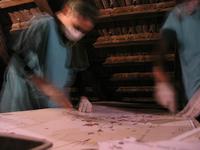
[ Site specific performance/ installation. ]
storage room 1
Ariane Littman-Cohen in collaboration with Irit Amar
Mixed Media, sound, video and red lights
Performance length: seven hours
Nurses: Irit Amar & Kim Sigal, surgeons: Mack Elazar & Ariane Littman-Cohen
Sound track: Kiki Keren-Huss
Video: Ariane Littman-Cohen, The Gaze, 2001
Surgical Action, 2004 was performed for seven hours in the storage room of the Anglican School which cleared of its junk had been reorganize with old hospital forgotten ready-mades. It had several ‘stations’ lighten in red dim lights, physically inaccessible to the public. The performance took place at the far-end of the attic and was accessible to the public. During seven hours two doctors dressed as surgeons performed surgical operations on maps of Jerusalem. The maps printed by OCHA Humanitarian Information Centre and distributed by the UN office for the Coordination of Humanitarian Affairs, were ‘Closure Maps’ showing the checkpoints, barriers and road networks of the Jerusalem region located beyond the Green Line. The maps brought by two surgeons on an old forgotten military stretcher to the operation table were then cut piece by piece and hang up on thin ropes. These fragments pick up by the nurses were then either sewn on a thin white cloth with a green cotton thread or meticulously patched with plaster bandages. As the work proceeded through the night, these new maps were suspended behind the operation table.
This Installation/Performance was accompanied by three different soundtracks: the electronic sound of the video The Gaze located in-between the rubbles of a ‘field hospital and broken kitchen equipment.’ The voice of a mother narrating bedtime stories to her daughter emerging from a transistor placed in a broken baby cot. While next to the operation table, the opening soundtrack of army radio and TV news erupted every two minutes, with short and edited reports of terrorist attacks in the city over the past two years.
Surgical Action, 2004 was created bearing in mind the complex history of that beautiful building which since 1862 had intermittently hosted on its premises various hospitals and schools. During seven hours, actions were obsessively repeated: maps of Jerusalem’s separation wall were brought on a stretcher to be dissected, sewn and mended amidst the recurring breaking news, conveying in a metaphorical way the chronic condition of the city of Jerusalem, a sick ‘patient’ whose pathological violence seems incurable.